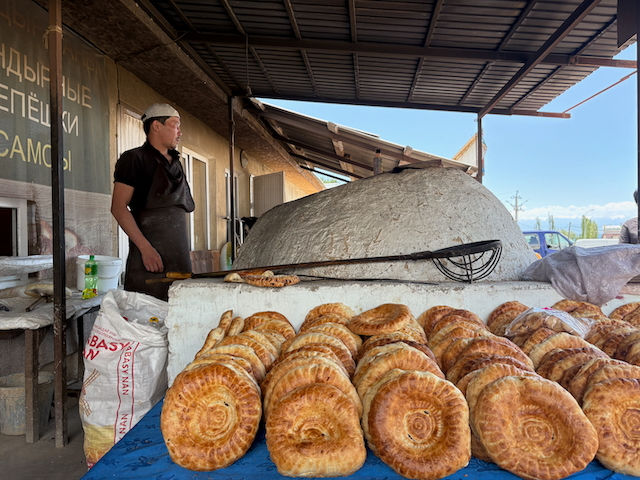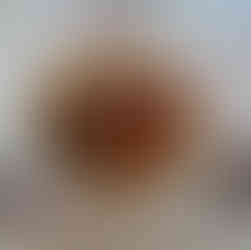Exploring Northern Kyrgyzstan
- Ian Rosenberg

- Jun 23
- 6 min read
Zack and I left Almaty at the international bus station to head to our eighth country of the trip: Kyrgyzstan!

Our first impressions of the country were pretty rough. We were stuck at the bus terminal with no cash, no working atms, and no way to pay for our way out. We ended up exchanging the last few of Zack’s US dollars and the few bucks in Kazakh tenge we had. Luckily, this would be one of the only frustrating moments in all our time here. Eventually, we were able to get a bus to Cholpon Ata: Kyrgyzstan’s resort town on the inland sea, Issyk Kul.
The bus we took was the first of a few marshrutkas that would get us around. A marshrutka is a mini bus that leaves when full, offering very low fares for long drives across the country. They’re usually pretty poorly ventilated and pressed for leg room, but for $5 for a 6 hour drive, you can’t really complain much. They stop along the way to pick up and drop off people too, and the fares are listed in an official sheet.
That’s one thing about Kyrgyzstan that’s just been so nice. People here are honest. If the company sets a fare for a certain ride, the driver will ask you for that fare. They’re not going to up-charge you, making you knock the price down until it’s something reasonable. It’s the same thing at markets: you can bargain, of course, but I’ve found usually the first price given to be quite fair. People here are respectful of your money and care about honesty. I’ve never really run into a person here that I felt had ripped me off or tried to take advantage of me for being a foreigner. In fact, it’s quite the opposite. People will come up to us all the time to introduce themselves, welcome us to Kyrgyzstan, and will go out of their way to recommend things for us to eat and do.
The road out to Issyk Kul looked a lot like driving the section of I-70 west of Denver. We were driving through valleys with mountains that would make great ski resorts on either side of us. But we also saw out the window mosques that look like no other mosques I’ve ever seen. They look like they were just at one point buildings that were turned into mosques later. I figure this could be due mostly to the Soviet era. At that time, overt practice of religion, especially Islam, was not allowed. I figure they would have had to have their mosques as regular buildings and use them discretely to continue to practice their religion. When that era ended, instead of building mosques anew, they just tacked on prefabricated domes to the top of the previous ones. Many mosques here also don’t have minarets. Much like the domes, minarets were a sign of religious practice and a public way of celebrating Islam. Thus, I could also imagine that minarets were not around in the Soviet times. While they do have call to prayer in Kyrgyzstan, it’s often quiet or subtlety acknowledged. It’s not the cacophony of Marrakesh or Dubai.

We made it to Cholpon Ata but we know how to stop the marshrutka, so we ended up staying on for too long and had to walk 45 minutes back to town…
Cholpon Ata was a decent introduction to Kyrgyzstan. Its architecture somewhat is in the Kyrgyz style, but it’s heavily Soviet. The city was created mainly as a draw for Soviet tourists who wanted a beach vacation. Issyk Kul is, I guess, one of the closest things you could get to a beach back in the USSR. I mean even the main street of the city is called Soviet Street.
Cholpon Ata gave us our first look at the multiculturalism present in Kyrgyzstan. Instep of national groups, as in Almaty, the diversity here is mostly that of stateless people. Here, Kyrgyz food and traditions mix with Dungan, Uighur, and Tatar customs to create something so unique.
From left to right: Lagman, Ashlyanfu, Manty, Kurrdak
The strongest influence we saw was Dungan: Chinese Muslims. Whereas I’d gotten used to Central Asian food as on the blander side, very heavy on meat and this sour, fermented dough from my time in Kazakhstan and Mongolia, the food here in Kyrgyzstan is so different, in fact, it’s among my favorite cuisines I’ve had (still doesn’t beat Thai though, for sure…).
Most Dungan dishes are Chinese inspired, using lots of soy sauce, vegetables, rice and noodles, and spices. The most famous dishes are Lagman and Ashlyanfu. Lagman is a pulled dry noodle dish served either stir fried or with a meat gravy. It tastes like something a five hour flight east of here, not like it’s from Central Asia. Zack and I got Lagman plenty of times in Kyrgyzstan, and it was fun to try all the different kinds of gravies and sauces.
The second dish, nearly synonymous with the cuisine of eastern Kyrgyzstan, is ashlyanfu. Zack and I first encountered it at a restaurant in Cholpon Ata, where the people next to us were all having a bowl. I asked them what it was, not realizing that it was quite literally the most famous dish from around here. They told us the name and recommended it highly. Zack and I tried it that night, and were so amazed by it that we got a second bowl.
Ashlyanfu is a cold soup with a vinegar base, using chili, garlic, and green onions as spice. There’s two kinds of noodles: egg and starch. The egg noodles are usually hand pulled lagman noodles, and the starch noodles are made by using a grater on a block of starch. We got to make these starch noodles later on in the trip. I can tell by the way I’m describing it that nothing really sounds that good. Vinegar soup? Giant block of starch? Kinda gross. But amazingly everything works together to make a really incredible dish.
It’s worth noting that usually a bowl of ashlyanfu costs about 80 cents, and a good hearty portion of Lagman can run you up to gasp $2.00. Food is criminally cheap here, and Zack and I managed to feast nearly every meal for less than $10 total. (Except for a sushi restaurant. That was actually pretty pricey. Oh no! $11 a person for three rolls of sushi, two desserts, and a liter of non alcoholic mojito! What would we ever do???)
We spent our day in Cholpon Ata seeing the city’s main sites: some petroglyphs, the beach, the monument, the main bazaar, and a park dedicated to religious and cultural diversity. Nothing too crazy to write all that much about, but I do wanna mention our walk to the petroglyphs.
The petroglyphs are at the far edge of the town, and Zack and I decided to walk so we could get a good idea of what the different areas of town are like. We walked through the local neighborhoods—not the areas created as a Soviet tourist beach haven. We got a little lost in these streets that are not repressed at all on Google Maps. But several times, we got directed by friendly locals to the right path. One group of local guys, who looked to be probably in their 50s or 60s, were all just sitting outside talking and enjoying some fruit. They stopped us and we had a nice conversation, telling them about how we found Kyrgyzstan and what life is like here versus in America. I regret not having spent more time with them, because it seemed like an authentic Kyrgyz experience waiting to happen, but we continued onto the petroglyphs instead.
One other thing I should mention is that we got our first Lepeshka, Uzbek bread, here as well. The bread is baked in a clay oven and it has this beautiful pattern in the center. I had the guy show me the inside of the oven, which was just a pretty deep pit of fire. But the fresh baked bread was nice and soft. The pattern was fun to eat as well!

I think that’s most of what I have to say about Cholpon Ata. I’ll continue in a later post about Karakol—Kyrgyzstan’s fourth largest city.









Comments